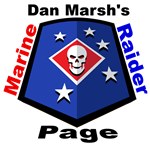The Brigade
On returning to Guadalcanal, we soon learned that another change in our designation had taken place. In March, while we were on Emirau the First Provisional Marine Brigade had been activated on Guadalcanal. The 4th Marines and 22nd Marines had been united as the Brigade under the command of Brig. General Lemeul Shepherd former ADC of the 1st Marine Division. General Shepherd faced the enormous task of integrating two independent regiments and all supporting elements, into a unified command before their services were required. Future events would prove that he was more than equal to the assignment.
All units of the Brigade began an intensive period of training and preparation for their next combat assignment. Aware of the victories in the Gilbert and Marshall Islands, we sensed that we would be a part of the accelerated amphibious assault sweeping across the pacific.
During the period of 25-27 May, the Brigade and all supporting units participated in a full dress rehearsal of an amphibious combat landing. In the ship to shore operations, marines practiced transferring from landing craft to tractors, at the edge of a simulated reef. These exercises were made as realistic as possible, by the use of live ammunition, and bombs in providing air support. These exercises were the culmination of our training, and when they were completed an alert for movement was soon received. The Brigade immediately began loading activities and embarking at Kukum. Company K embarked on the USS Clymer, which would prove to be our home much longer than we expected or desired.
Once settled aboard the Clymer, we were briefed concerning our mission. We were very surprised and excited to learn that we were to be part of a well planned but bold stroke, at the Japanese main line of defense in the Marianas Islands. The 2nd and 4th Marine Divisions, with the army’s 27th Infantry Division in reserve, would assault Saipan on 15 June. Our Brigade and the 3rd Marine Division, with the 77th Infantry Division in reserve, would assault and liberate the island of Guam, three days later on 19 June.
Ordeal At Sea
The coordinated assault on Saipan took place as scheduled. Both Marine Divisions were meeting heavy resistance, but steady progress was being made. Casualties were very heavy, which was one factor in a change of plans for the invasion of Guam. The Japanese fleet had finally came out, and was approaching Saipan, which was the other factor. For ten days, the troop ships of the Guam task force stood off Saipan during daylight hours ready to go ashore if they were needed. On 25 June, the transports of the 3rd Division were released by Admiral Spruance to retire to a re-staging area near Eniwetok. The Admiral however, did not release the Brigade until 30 June. Eventually "W" day (D day for Guam) was advanced to 21 July.
For the Marines aboard all the transports, the boredom and monotony became almost unbearable. The only words that can accurately describe the troop compartment of an attack transport, are "sweat and stink". Consequently, we tried to stake out a homestead, which made life miserable for the ship’s crew.
Twice a day they had to accomplish a clean sweep down fore and aft the ship. A group of us played pinochle hour after hour. First with one deck, then two decks, then three decks until we exhausted the chaplain’s supply. One day I recall, the company was transported to Eniwetok to exercise in the hot sun. Except for that one brief respite, we remained on the Clymer until " W" day, 21 July. General Geiger in command of the Third Amphibious Corps has been quoted as saying that the prolonged voyage had no ill effects upon the troops. Well, most of us did not see things that way. In early July our transports finally departed the lagoon at Eniwetok for Guam.
The postponing of W-Day gave the Japanese almost two months to prepare for our assault. The preparatory fires by Task Force 53, beginning on 16 June, in anticipation of our scheduled assault made it clear where we planned to land. However, it also gave the fleet’s warships and planes an extended opportunity to destroy their defenses. From 8 July, to W-Day, the enemy was subjected to a merciless pounding by air and sea. On 14 July, Admiral "close in Conolly," took personal command of the proceedings. As always, he more than lived up to his nickname.
NOTE: [The plans, movements and operations of the 3rd Marine Division and the 77th Infantry Division, are beyond the scope of this narrative. Since these pages are personal, the story line will be confined to the 4th Marines and in particular K Company 3rd Battalion].
The operational plan for the 1st Brigade, called for the two regiments to go ashore abreast between Agat and Bangi Pt. The 22nd Marines to the north on yellow beaches 1 and 2; the 4th Marines on white beaches 1 and 2 to the south.
The beaches extended for a mile or more with Gaan Pt. In the middle. The 4th Marines would land with the First and Second Battalions in the assault, transported across the 300 yards of reef in LVT’s. The 3rd Battalion in reserve, would transfer at the reefs edge to LVT’s as they returned, and then proceed to the beach. The 22nd Marines would move inland bearing left to seal off Orote Peninsula while, the 4th Marines would extend the beachhead and guard the Brigades right flank. Tension was mounting, as the invasion force of 274 ships quietly moved into position the night of 20 July. H- Hour was confirmed to be at 0830 21 July.
